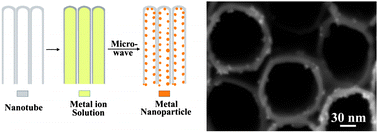Synthesis and deposition of ultrafine Pt nanoparticles within high aspect ratio TiO2nanotube arrays: application to the photocatalytic reduction of carbon dioxide
Abstract
Using a rapid microwave-assisted solvothermal approach ultrafine Pt

* Corresponding authors
a The Materials Research Institute, The Pennsylvania State University, University Park, PA, USA
b
State Key Laboratory of Materials-Oriented Chemical Engineering, College of Chemistry and Chemical Engineering, Nanjing University of Technology, Nanjing, China
E-mail:
craig.grimes40@gmail.com
Using a rapid microwave-assisted solvothermal approach ultrafine Pt

 Please wait while we load your content...
Something went wrong. Try again?
Please wait while we load your content...
Something went wrong. Try again?
X. Feng, J. D. Sloppy, T. J. LaTempa, M. Paulose, S. Komarneni, N. Bao and C. A. Grimes, J. Mater. Chem., 2011, 21, 13429 DOI: 10.1039/C1JM12717A
To request permission to reproduce material from this article, please go to the Copyright Clearance Center request page.
If you are an author contributing to an RSC publication, you do not need to request permission provided correct acknowledgement is given.
If you are the author of this article, you do not need to request permission to reproduce figures and diagrams provided correct acknowledgement is given. If you want to reproduce the whole article in a third-party publication (excluding your thesis/dissertation for which permission is not required) please go to the Copyright Clearance Center request page.
Read more about how to correctly acknowledge RSC content.
 Fetching data from CrossRef.
Fetching data from CrossRef.
This may take some time to load.
Loading related content
